Microstructural Evolution and Mechanical Properties of Spark Plasma Sintering of Tantalum-Tungsten Alloy
Abstract
1. Introduction
2. Experimental Details
2.1. Material Preparation
2.2. Powder Mixing
2.3. Spark Plasma Sintering
2.4. Density Measurements
2.5. Microscopic Analysis
2.6. Micro-Hardness Test
2.7. Mechanical Property Investigation
3. Results and Discussion
3.1. Relative Density of Ta-W alloy
3.2. Microstructural and Phase Characterization of Ta-W Alloys
3.3. Micro-Hardness
3.4. Mechanical Properties and Morphologies
4. Conclusions
Author Contributions
Funding
Data Availability Statement
Conflicts of Interest
References
- Kuznietz, M.; Livne, Z.; Cotler, C.; Erez, G. Diffusion of liquid uranium into foils of tantalum metal and tantalum-10 wt% tungsten alloy up to 1350 °C. J. Nucl. Mater. 1988, 152, 235–245. [Google Scholar] [CrossRef]
- Yasunaga, K.; Watanabe, H.; Yoshida, N.; Muroga, T.; Noda, N. Correlation between defect structures and hardness in tantalum irradiated by heavy ions. J. Nucl. Mater. 2000, 283-287, 179–182. [Google Scholar] [CrossRef]
- Liu, S.; Fan, H.; Deng, C.; Hao, X.; Guo, Y.; Liu, Q. Through-thickness texture in clock-rolled tantalum plate. Int. J. Refract. Met. Hard Mater. 2014, 48, 194–200. [Google Scholar] [CrossRef]
- Browning, P.N.; Alagic, S.; Kulkarni, A.; Matson, L.; Singh, J. Room and ultrahigh temperature structure-mechanical property relationships of tungsten alloys formed by field assisted sintering technique (FAST). Mater. Sci. Eng. A 2016, 674, 701–712. [Google Scholar] [CrossRef]
- Xie, Z.; Miao, S.; Liu, R.; Zeng, L.; Zhang, T.; Fang, Q.; Liu, C.; Wang, X.; Lian, Y.; Liu, X.; et al. Recrystallization and thermal shock fatigue resistance of nanoscale ZrC dispersion strengthened W alloys as plasma-facing components in fusion devices. J. Nucl. Mater. 2017, 496, 41–53. [Google Scholar] [CrossRef]
- Chen, Y.; Zhu, S.; Wang, X.; Yang, B.; Han, G.; Qiu, L. Microstructure evolution and strengthening mechanism of Al 0.4 CoCu 0.6 NiSi x (x=0–0.2) high entropy alloys prepared by vacuum arc melting and copper injection fast solidification. Vacuum 2018, 150, 84–95. [Google Scholar] [CrossRef]
- Gwalani, B.; Soni, V.; Lee, M.; Mantri, S.; Ren, Y.; Banerjee, R. Optimizing the coupled effects of Hall-Petch and precipitation strengthening in a Al 0.3 CoCrFeNi high entropy alloy. Mater. Des. 2017, 121, 254–260. [Google Scholar] [CrossRef]
- Malopheyev, S.; Kulitskiy, V.; Kaibyshev, R. Deformation structures and strengthening mechanisms in an Al Mg Sc Zr alloy. J. Alloy. Compd. 2017, 698, 957–966. [Google Scholar] [CrossRef]
- Ritter, N.C.; Roman, S.; Schauer, J.C.; Gruber, D.; Goehler, T.; Rettig, R.; Povoden-Karadeniz, E.; Koerner, C.; Singer, R.F. Effects of Solid Solution Strengthening Elements Mo, Re, Ru, and W on Transition Temperatures in Nickel-Based Superalloys with High γ′-Volume Fraction: Comparison of Experiment and CALPHAD Calculations. Met. Mater. Trans. A 2018, 49, 3206–3216. [Google Scholar] [CrossRef]
- Walbrühl, M.; Linder, D.; Ågren, J.; Borgenstam, A. Modelling of solid solution strengthening in multicomponent alloys. Mater. Sci. Eng. A 2017, 700, 301–311. [Google Scholar] [CrossRef]
- Liu, W.; Huang, Y.; Wang, Y.; Zhang, Y.; Duan, X.; Liu, W.; Ma, Y. Microstructure and mechanical properties of W-10 wt-%Ta alloys prepared by spark plasma sintering. Mater. Sci. Technol. 2022, 38, 159–168. [Google Scholar] [CrossRef]
- Moeen, A.; Gholam Hossein, B.; Saeed Reza, B.; Hassan, S. Development of high densified tantalum-tungsten alloy by powder metallurgy route. Mater. Res. Express. 2019, 6, 0865h5. [Google Scholar] [CrossRef]
- Li, B.; Sun, Z.; Hou, G.; Ding, F.; Hu, P.; Yuan, F. The effects of alumina reinforcement and nickel activated sintering on nanosized tungsten matrix. J. Alloy. Compd. 2017, 692, 420–426. [Google Scholar] [CrossRef]
- Guo, Z.; Wang, L.; Wang, X.-Z. Additive manufacturing of W-12Ta(wt%) alloy: Processing and resulting mechanical properties. J. Alloy. Compd. 2021, 868, 159193. [Google Scholar] [CrossRef]
- Dong, C.; Bi, X.; Yu, J.; Liu, R.; Zhang, Q. Microstructural evolution and sintering kinetics during spark plasma sintering of pure tantalum powder. J. Alloy. Compd. 2018, 781, 84–92. [Google Scholar] [CrossRef]
- He, T.; He, Y.; Li, H.; Su, Z.; Fan, Y.; He, Z. Fabrication of Ni-W-B4C composite coatings and evaluation of its micro-hardness and corrosion resistance properties. Ceram. Int. 2018, 44, 9188–9193. [Google Scholar] [CrossRef]
- Tahiri, M.; Masaif, N.; Jennane, A. Theoretical Study of Spontaneous Polarization Behavior and Density Behavior of Ni-Doped LiMO3(M˭Nb or Ta). Ferroelectrics 2015, 481, 189–195. [Google Scholar] [CrossRef]
- Liu, K.; Ning, C.; Luo, Z.; Shi, L.; Deng, J. An experimental and theoretical study of the HOMO of W(CO)6: Vibrational effects on the electron momentum density distribution. Chem. Phys. Lett. 2010, 497, 229–233. [Google Scholar] [CrossRef]
- Nogami, S.; Ozawa, I.; Asami, D.; Matsuta, N.; Nakabayashi, S.; Baumgärtner, S.; Lied, P.; Yabuuchi, K.; Miyazawa, T.; Kikuchi, Y.; et al. Tungsten–tantalum alloys for fusion reactor applications. J. Nucl. Mater. 2022, 566, 153740. [Google Scholar] [CrossRef]
- Foronda, H.M.; Mazumder, B.; Young, E.C.; Laurent, M.A.; Li, Y.; DenBaars, S.P.; Speck, J.S. Analysis of Vegard’s law for lattice matching InxAl1−xN to GaN by metalorganic chemical vapor deposition. J. Cryst. Growth 2017, 475, 127–135. [Google Scholar] [CrossRef]

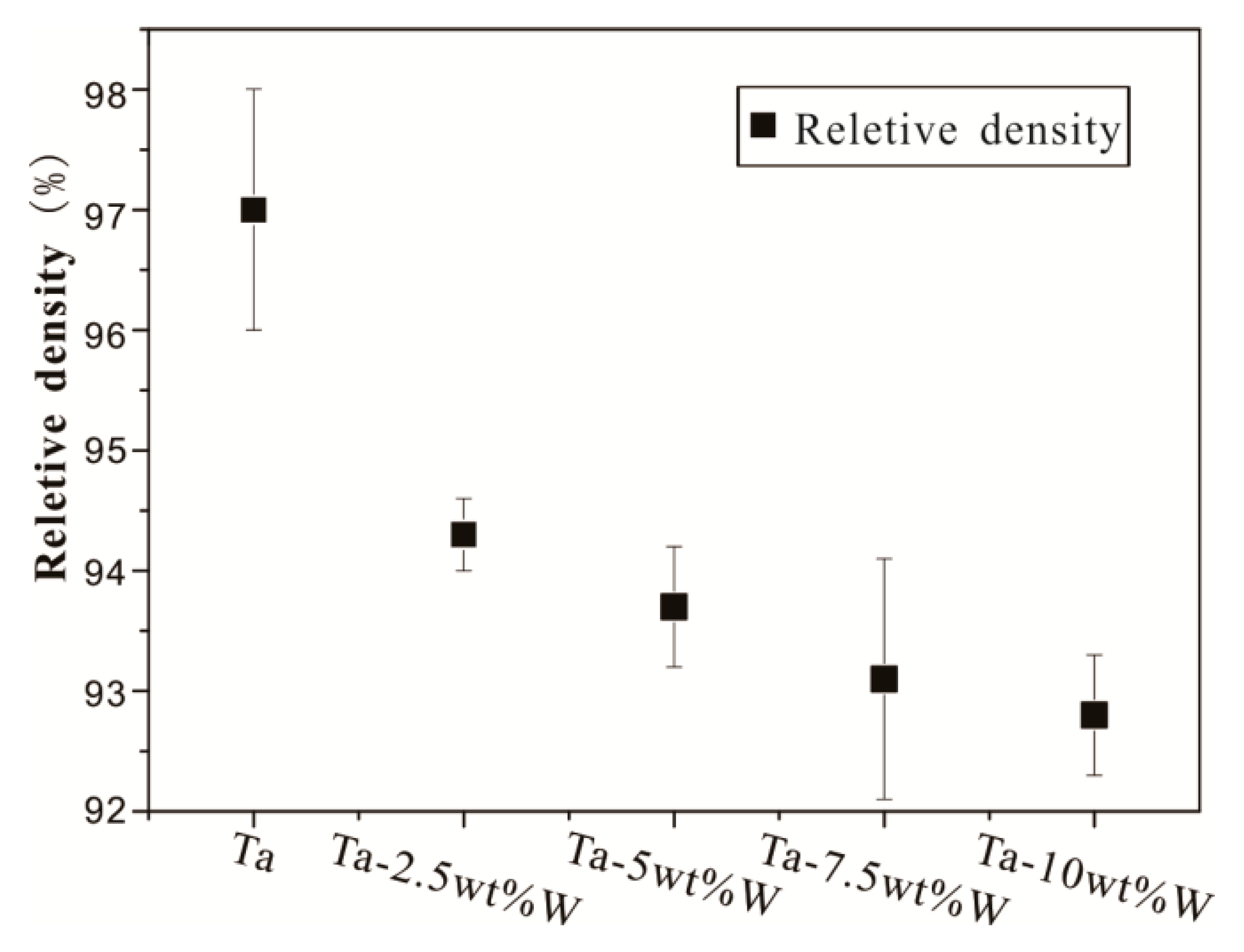
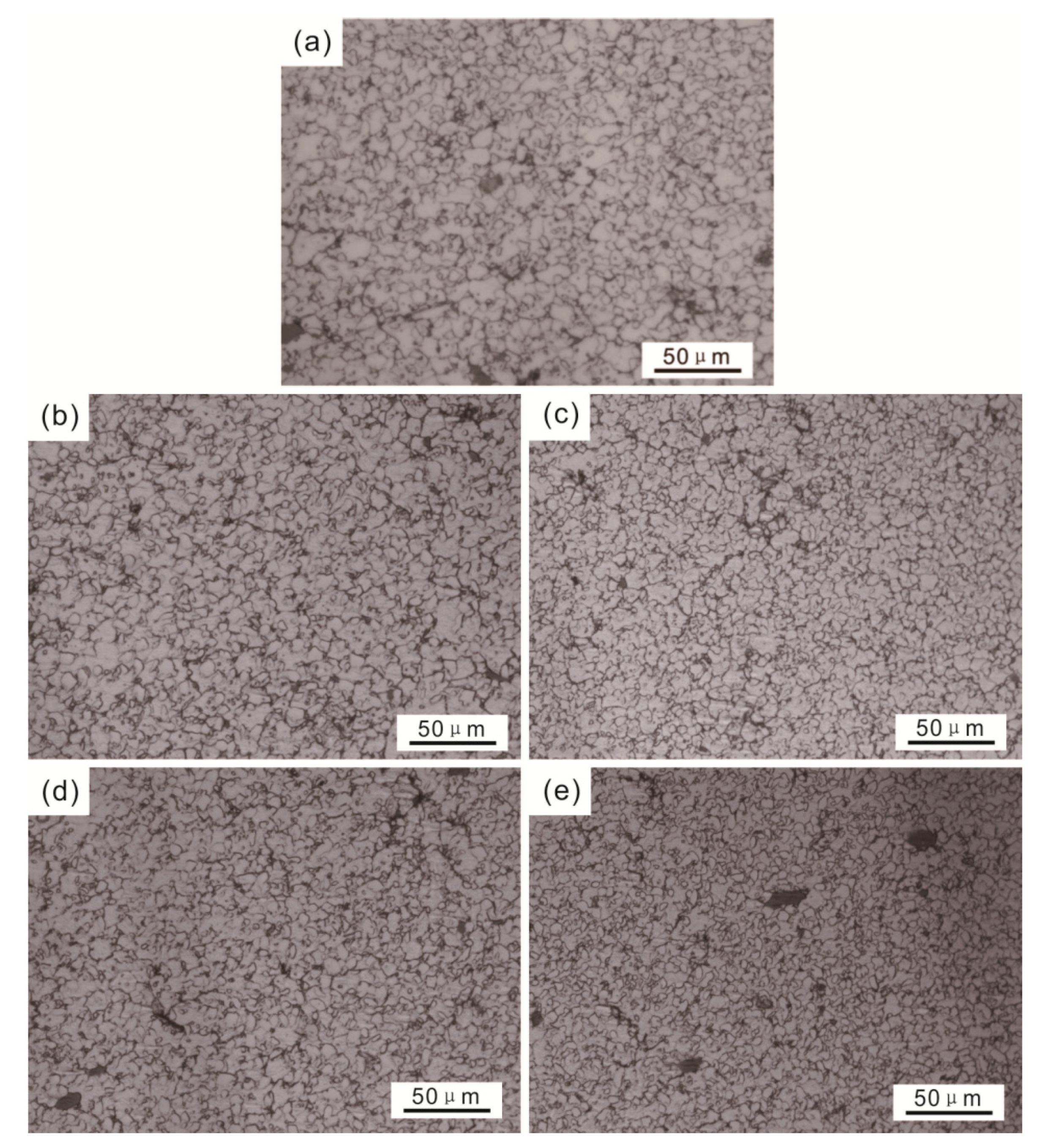
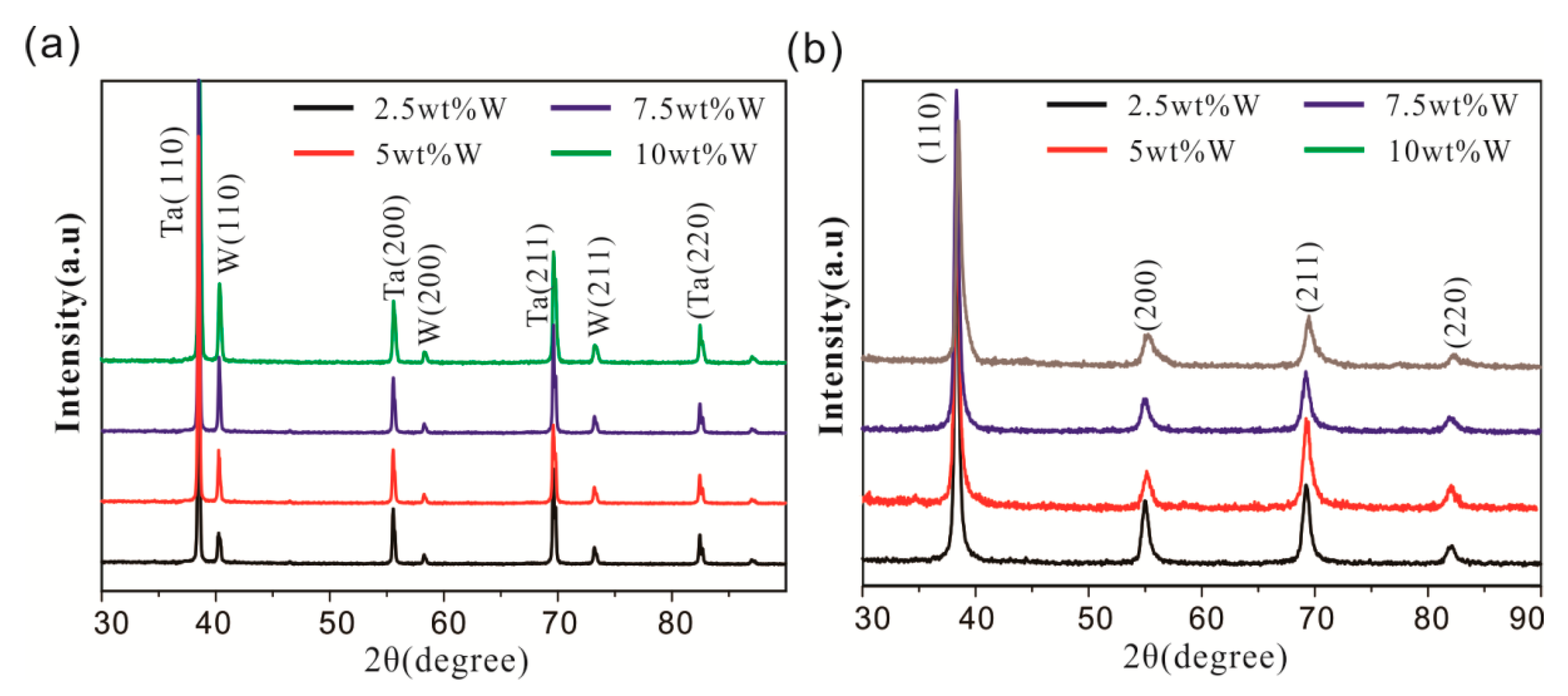

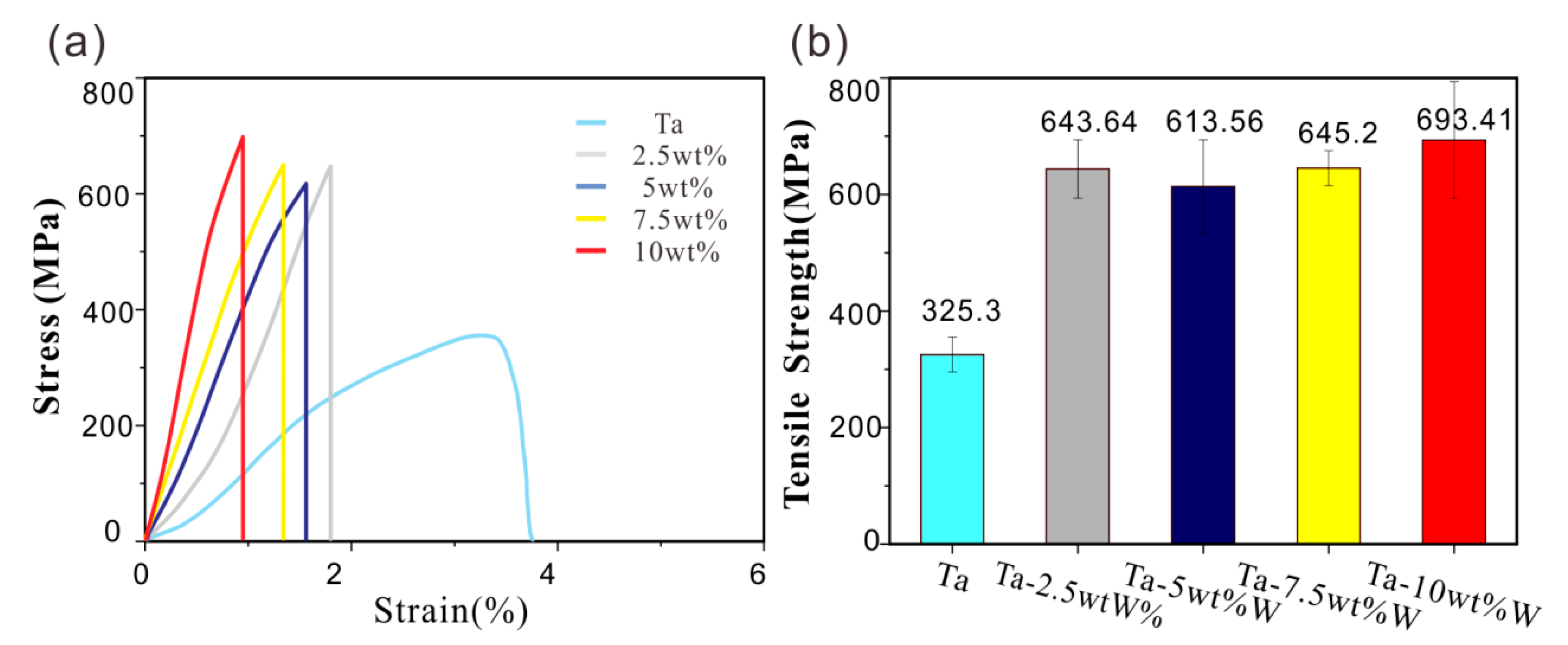

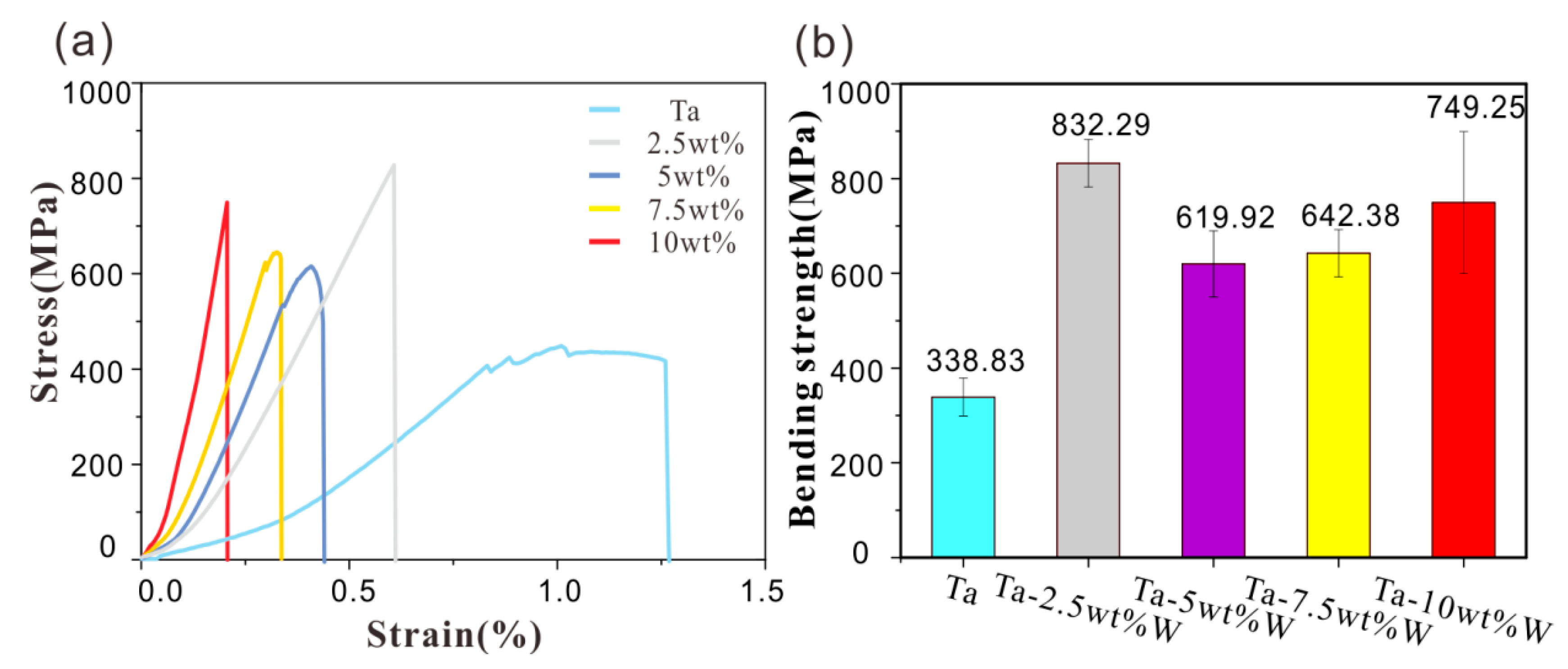

| Ta Powder | W Powder | ||
|---|---|---|---|
| Specific surface area (m2/g) | 0.39 | 1.96 | |
| Surface area mean particle size (μm) | 15.385 | 3.056 | |
| Volume mean particle size (μm) | 22.724 | 6.095 | |
| Particle dimension distribution (μm) | D10 | 8.851 | 1.536 |
| D50 | 20.536 | 3.739 | |
| D90 | 40.155 | 12.969 | |
| Chemical composition (ppm) | O | 1500 | 610 |
| C | 80 | - | |
| H | 30 | - | |
| N | 20 | - |
| Alloy | Theoretical Value | Measured Value |
|---|---|---|
| Ta | 3.3060 | 3.3029 |
| Ta-2.5 wt%W | 3.3025 | 3.3024 |
| Ta-5 wt%W | 3.2991 | 3.2995 |
| Ta-7.5 wt%W | 3.2956 | 3.2958 |
| Ta-10 wt%W | 3.2919 | 3.2920 |
Disclaimer/Publisher’s Note: The statements, opinions and data contained in all publications are solely those of the individual author(s) and contributor(s) and not of MDPI and/or the editor(s). MDPI and/or the editor(s) disclaim responsibility for any injury to people or property resulting from any ideas, methods, instructions or products referred to in the content. |
© 2023 by the authors. Licensee MDPI, Basel, Switzerland. This article is an open access article distributed under the terms and conditions of the Creative Commons Attribution (CC BY) license (https://creativecommons.org/licenses/by/4.0/).
Share and Cite
Yu, D.; Bi, X.; Xing, L.; Zhang, Q. Microstructural Evolution and Mechanical Properties of Spark Plasma Sintering of Tantalum-Tungsten Alloy. Metals 2023, 13, 533. https://doi.org/10.3390/met13030533
Yu D, Bi X, Xing L, Zhang Q. Microstructural Evolution and Mechanical Properties of Spark Plasma Sintering of Tantalum-Tungsten Alloy. Metals. 2023; 13(3):533. https://doi.org/10.3390/met13030533
Chicago/Turabian StyleYu, Dong, Xianlei Bi, Lei Xing, and Qiaoxin Zhang. 2023. "Microstructural Evolution and Mechanical Properties of Spark Plasma Sintering of Tantalum-Tungsten Alloy" Metals 13, no. 3: 533. https://doi.org/10.3390/met13030533
APA StyleYu, D., Bi, X., Xing, L., & Zhang, Q. (2023). Microstructural Evolution and Mechanical Properties of Spark Plasma Sintering of Tantalum-Tungsten Alloy. Metals, 13(3), 533. https://doi.org/10.3390/met13030533




